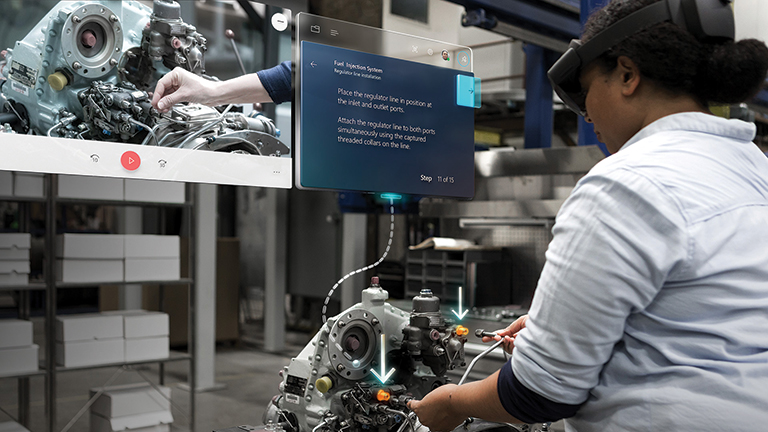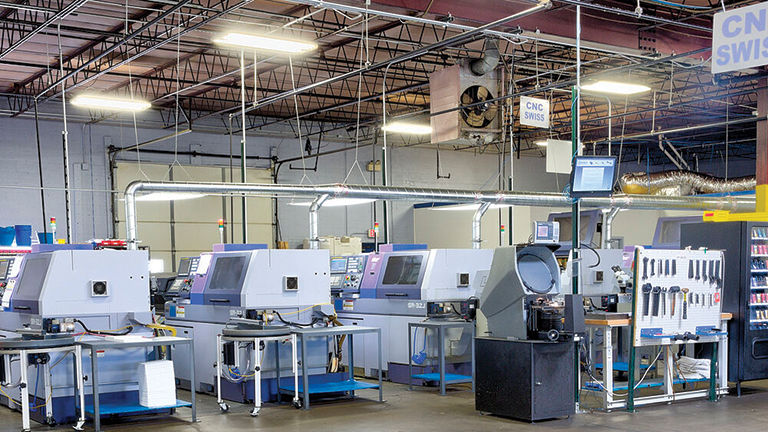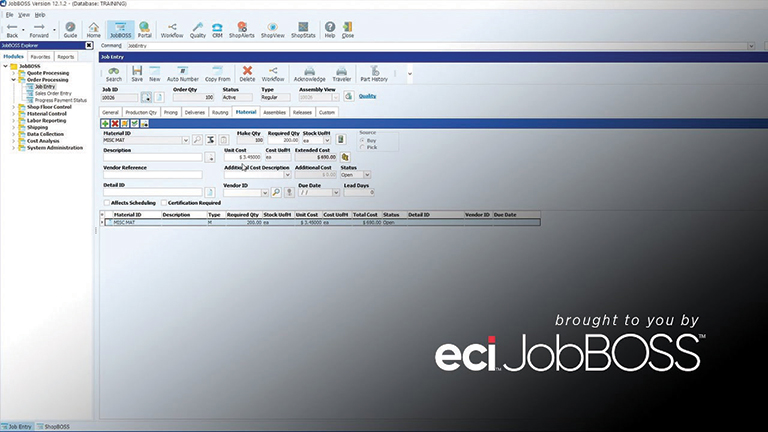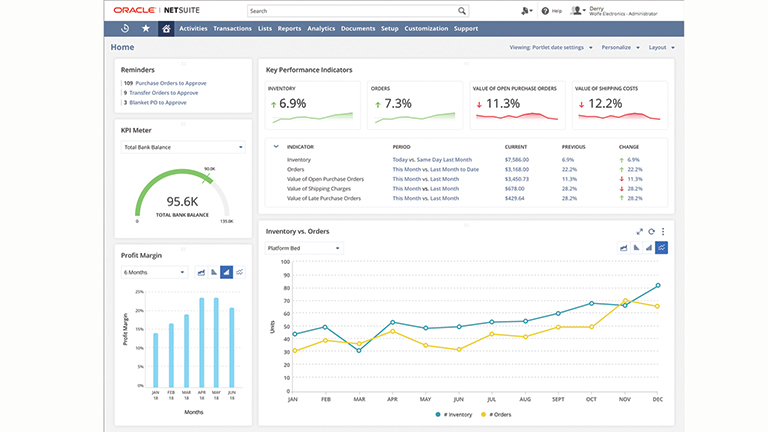Enterprise resource planning software grows smart and data-aware

As with so much else in manufacturing, enterprise resource planning (ERP) software is a byproduct of the Third Industrial Revolution. Where electronics began transforming manual lathes and mills into CNC machine tools some 60 years ago, so too have computers and information technology given us CAD/CAM, ERP, PLM, and so much more. At the risk of sounding like Captain Obvious, all of this has changed how we work, share information, and, most importantly, make things. What’s not so obvious, though, is where the industry is headed.
Terms like cloud computing and big data have begun creeping into the manufacturing lexicon, leaving many to react as our great-grandparents did upon seeing the first vacuum tube: “What the heck is that?” Whether you’re comfortable with technological change or not, however, it should be clear to everyone by now that the Industrial Internet of Things (IIoT) and Industry 4.0 are poised to disrupt manufacturing as we know it. Both will give shops more information, improved decision-making capabilities, and greater visibility into their processes than ever before. Both will also make manufacturing far more complicated, but at the same time easier and more productive.
Continuously Improving with Data
The question then becomes, how exactly will ERP systems handle big data? Will traditional data collection and manufacturing execution systems disappear in the face of smart machine tools and interconnected systems? And what tools will ERP providers offer to shops wishing to harness the IIoT? These are all excellent questions, and if you’re ready to take the next step forward, there’s also some good news: you’ll have plenty of advice, starting with some predictions from Rose of Sharon DeVos, continuous improvement consultant with Global Shop Solutions Inc., The Woodlands, Texas.
“ERP systems like Global Shop Solutions already have the infrastructure in place to accept data from many different inputs, then use that data to drive increased productivity and visibility into different areas of the company, whether it’s scheduling, inventory, finances, or other areas,” she said. “Industry 4.0 will improve all that. Instead of employees performing manual data input, this activity will be both automatic and in real-time, saving valuable time. Data quality will also be better, with the granularity needed to see where and when certain events are happening. Not only will people be able to make better, more timely decisions, but the machine tools, people, and software systems will all be part of a big, data-based ecosystem. That’s the ultimate value behind Industry 4.0 and the IoT.”

Ashwin Dsouza, product owner for continuous improvement at Global Shop Solutions, added to DeVos’ comments, emphasizing the term “automation” in a way that’s different than the traditional definition of robots and other material handling systems. Dsouza said there’s a great deal of interest throughout the industry in ERP software that reduces data entry and other human interactions. As you might expect, this means integration with CNC machine tools, CAD/CAM and other software systems, and equipment such as offline presetters and tool vending machines. But it also means having a way to separate the wheat from the chaff, so to speak, in the deluge of big data that the IIoT is capable of generating.
Taming the Wild West
For this, Global Shop Solutions—as with others interviewed for this article—provides dashboards, reports, and event-triggered alerts, any of which can be modified (or built from scratch) to fit a shop’s unique needs. Yet gathering, filtering, and then analyzing the potentially massive amounts of data needed to fill these business intelligence tools often requires an additional step, one that includes integration with third-party platforms (most of which are cloud-based) as well as familiarity with protocols like SOAP (simple object access protocol) and REST (representational state transfer).
That’s according to Global Shop Solution’s Chief Technology Officer Chris Okamuro, who explained that an entire industry has arisen over the past five years or so to address what has become the “Wild West” in terms of communication standards. “Aside from the protocols just mentioned, there’s also OPC (open platform communications), MTConnect, XML, and others,” he said. “So while it can be done, this diversity means it doesn’t usually make sense to take data directly from a machine tool or other piece of manufacturing equipment. What’s needed instead is some sort of middleware that collates big data into one location, and once it’s there, gives ERP providers a way to pull out what’s needed for analysis and reporting. That’s what these third-party providers bring to the table.”

Epicor Software Corp., Austin, Texas, takes a similar approach, having partnered with Microsoft and its Azure platform to collect information from the shop floor and stream it to the cloud for analysis and visualization. Andrew Robling, principal product manager, offered a simple example: monitoring the cutting fluid in a machine tool, where action must be taken if the level falls below a certain threshold.
“For us, we might handle this with a BPM (business process management) rule, which can trigger an alert or possibly generate a maintenance work order,” he said. “The same thing can be done with any equipment-related event, though, whether it’s spindle temperature, tool life, axis load, piece count, and so on—if it’s being monitored, we can establish rules to send a notification, update a dashboard, fire off a report, or get someone out of bed at night.”
Data Equals Dollars
As mentioned earlier, most ERP providers offer reporting and visualization capabilities within their software. In Epicor’s case, one such tool would be Epicor Data Discovery to visualize shop floor events, or Epicor Data Analytics, used to analyze historical data and trends. Both monitor the Microsoft Azure IoT Hub, Robling explained, and then make decisions on what information to bring into Epicor itself.
Automated decision-making like this is needed to control how much data is being collected, as well as the cost of collecting it. Because Azure is a cloud-based subscription service, the amount a customer pays per month is directly related to the number and frequency of data points monitored. Said Robling, “In our fluid level example, there’s no reason to check it every minute; once an hour is probably fine, or even every day. Being strategic in this regard will help to make everything about the IIoT more manageable.”
Two Azure experts are General Manager Manoj Swaminathan and Principal Program Manager Lachlan Cash, each a member of the Dynamics 365 Supply Chain Management and Manufacturing team at Redmond, Wash.-based Microsoft Corp. Both suggested that manufacturers are looking beyond traditional ERP functions for tools that will help them leverage the vast amounts of data that Industry 4.0 is making available to them.
“To support this, our most recent release of Dynamics 365 contains a number of Industry 4.0-related features, many of them leveraging the Azure IoT Hub,” said Swaminathan. “These include support for connected manufacturing, IIoT integration, real-time visibility to shop floor processes, mixed reality tools for training purposes, and tools that give supervisors, schedulers, and machine operators greater insight and decision-making ability.”
Note the term mixed reality. You’ll be hearing a lot about it over the coming years, along with its counterparts, virtual and augmented reality. Each of these technologies can be made to interact with another Industry 4.0 creation, the digital twin. A 3D virtual representation of practically any electromechanical object—tractors, pumping stations, jet engines, and, yes, CNC machinery—digital twins enable many important functions that have, until recently, been impossible or at least impractical to perform.

A maintenance technician, for example, might use the digital twin of a machine tool to predict when it will require service. Sensor data from an assembly line could be fed to a digital twin and compared to a set of pre-defined quality metrics, reducing the time needed for physical inspection. Digital twins give designers a way to optimize products and track their performance in the field. And they’re used to train machine operators, simulate manufacturing processes, and lay out factory floors, all in a virtual manner.
It’s for these reasons that digital twinning could soon be an essential part of your company’s current (or future) ERP system. “Just as an ERP system can read IIoT signals, so too can a digital twin receive those inputs,” said Swaminathan’s counterpart, Lachlan Cash. “This helps provide greater visibility to the shop floor while also presenting the information needed to determine a company’s key productivity indicators (KPIs). Together with platforms like the Azure IoT Hub, which serves to democratize shop floor data regardless of its source, these technologies represent the framework for any long-term Industry 4.0 strategy.”
Don’t forget the cloud, suggested Fred Tillman, vice president of product development at ECI Software Solutions Inc., Fort Worth, Texas. To enable Industry 4.0, you need robust data processing capabilities, excellent connectivity, and lots of data storage. Cloud-based computing uses large banks of servers housed in secure facilities, tended by highly-trained IT specialists and linked to the outside world via high-bandwidth Internet lines. It therefore removes the roadblocks faced by small and medium-sized manufacturing firms that wish to pursue a digital manufacturing approach.
“The cloud delivers on much of what’s needed in terms of IT infrastructure,” Tillman said. “Further, these resources are available at an increasingly economical price point, but they still give you the ability to scale rapidly as the business or its data collection needs grow, events that often go hand-in-hand. This is why we’re making a concerted effort to move all our products into the cloud, and particularly those that support Industry 4.0 initiatives.”

Logan Paquin, director of product management for ECI, agreed. He noted that ERP software has existed for many decades, and since its inception the amount of data available to its users has only grown. The IIoT is taking that proliferation to an entirely new level, however, almost to the point of overabundance, and it’s up to ERP providers and their partners to make this overabundance of data manageable. To that end, ECI has joined forces with technology provider Data Inventions Inc., Cincinnati, to develop two tools—Lojic Dashboards, and Alora, a machine intelligence platform—for users of ECI’s JobBOSS shop management software.
Making Sense of Data
“There’s a lot of data out there and our goal is to help our customers make sense of it,” Paquin said. “This is the reason for buying an ERP system in the first place—to understand whether you’re profitable or not, how you can increase efficiency, and to make better decisions overall. Accomplishing that in the context of Industry 4.0, though, means using the right data in the right amounts. User-configurable dashboards, machine intelligence, and automated, rules-based business activity monitoring, or BAM, are a big part of that.”
David Gustovich sees things in much the same way as his peers. As senior director of Oracle NetSuite’s Global Manufacturing Center of Excellence in Redwood Shores, Calif., he said ERP has evolved significantly. Users recognize that more data means they can make better decisions faster, and achieve greater agility. “To accomplish that, you need a fully integrated ERP solution, one that provides complete visibility to the entire business, including shop floor activities.”
You might also need artificial intelligence (AI). Gustovich explained that, as the amount of data increases, so does the need for machine learning. Having AI allows ERP software to become more predictive, able to spot trends that humans might not. “Our customers are asking us, ‘How do we harness all the rich information that the IIoT is making available to us, without all the paper processing and manual data analysis that would otherwise be necessary?’ Our answer is simple: with the right software systems, much of this is automatic.”
But even given a fully integrated, AI-capable ERP solution, there will always be external data sources to contend with—CAD/CAM, machining simulation software, nesting programs, tool management systems, product lifecycle management and other engineering platforms, quality software, and the list goes on. What good is it listening to a handful of equipment voices unless you can hear the entire choir?
This is the final piece of the Industry 4.0 and ERP puzzle, one that Gavin Davidson, NetSuite product manager, slides neatly into place. His solution? APIs, or application programming interfaces. If you’re a Star Trek fan, you might think of an API as the universal translator that Captain Kirk used to speak with the Klingons. It allows disparate software systems to share information, without all that import/export tedium. For example, an ERP system might use an API to capture a list of cutting tools from the shop’s programming software and relay it to the tool crib, or know what materials the design department just entered into the CAD system, then compare it against available inventory. Without robust, vendor-supported APIs, Industry 4.0-type integration becomes more challenging and costly.
“We see increased demand for this level of interoperability,” Davidson said. “Because so many legacy systems are standalone, i.e., not integrated, manufacturers often struggle with moving to the next step in their digital journey. An Industry 4.0-ready ERP platform like NetSuite, on the other hand, has open APIs so that shops can collect, organize, and compare data from other systems. This gives users more of a 360o view of the business. It helps them streamline operations and continuously improve. And with that, it allows them to not only generate the appropriate KPIs, but then use those same tools to measure themselves in real-time and move forward.”
"industry" - Google News
July 23, 2020 at 07:11PM
https://ift.tt/3fVF09u
ERP in the Age of Industry 4.0 - Advanced Manufacturing
"industry" - Google News
https://ift.tt/2RrQtUH
https://ift.tt/2zJ3SAW
Bagikan Berita Ini















Wow! Such an amazing and helpful post this is. I really really love it.Get ERP software in Ohio to manage the business process and integrate company financials accounting, inventory control, operations, reporting & human resource activities!
ReplyDelete